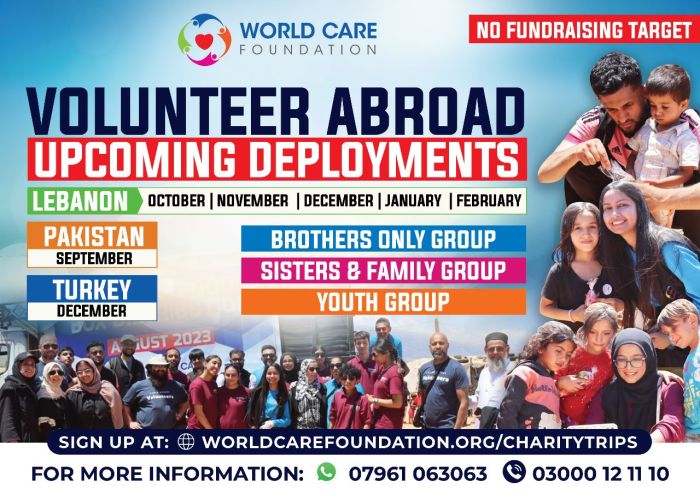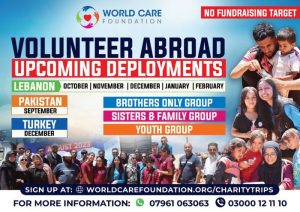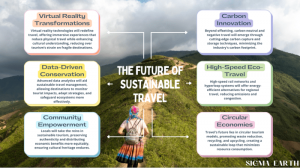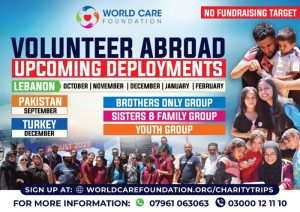
Best charity travel programs offer a unique opportunity to combine travel with meaningful contributions. These programs encompass a range of activities, from volunteering in underserved communities to supporting environmental conservation efforts. The experience is often transformative for both the traveler and the communities they engage with, fostering personal growth alongside positive social impact. Understanding the nuances of different programs, however, is crucial to ensure a rewarding and responsible experience.
This exploration delves into the various facets of best charity travel programs, examining their impact, the traveler experience, financial considerations, and ethical implications. We will provide guidance on selecting reputable programs, planning your trip efficiently, and maximizing your positive contribution while enjoying a fulfilling journey.
Defining “Best Charity Travel Programs”
Choosing the “best” charity travel program requires careful consideration of several interconnected factors. It’s not simply about the destination or the activity; it’s about the overall impact, the transparency of the organization, and the quality of the traveler’s experience. A truly excellent program balances these elements to create a mutually beneficial experience for both the traveler and the community being served.Defining “best” necessitates a multifaceted approach.
Impact refers to the tangible and measurable positive changes the program facilitates within the host community. Transparency involves clear communication regarding the program’s goals, how funds are utilized, and the actual impact achieved. A positive traveler experience, while seemingly secondary, is crucial; engaged and satisfied volunteers are more likely to contribute effectively and become advocates for the organization.
Types of Charity Travel Programs
Charity travel encompasses a spectrum of programs, each with its unique approach. Volunteer tourism directly involves travelers in hands-on projects, contributing their skills and labor. Responsible tourism focuses on minimizing the negative environmental and social impacts of travel while maximizing positive contributions through sustainable practices and supporting local businesses. Donation-based travel, while not involving direct volunteer work, allows travelers to contribute financially to specific projects or organizations, often with the opportunity to visit the impacted area.
Classification System for Charity Travel Programs
A useful classification system categorizes programs based on their primary focus. This helps travelers identify programs aligned with their values and interests.
- Environmental Conservation: These programs focus on protecting and restoring natural environments, including reforestation, wildlife conservation, and marine protection. An example might be a program involving coral reef restoration in the Philippines, where volunteers assist marine biologists in planting coral fragments.
- Community Development: These programs aim to improve the lives of local communities through projects like building schools, improving sanitation, or supporting local businesses. A program in Nepal might focus on building schools or providing educational resources in remote villages.
- Humanitarian Aid: These programs respond to immediate needs in crisis situations or provide ongoing support to vulnerable populations. Examples include disaster relief efforts after a natural disaster or providing medical care in underserved communities.
Impact Assessment of Charity Travel Programs

Measuring the effectiveness of charity travel programs is crucial to ensure their positive impact on both local communities and the environment. A robust assessment process allows organizations to refine their programs, attract further funding, and demonstrate their commitment to responsible tourism. Without rigorous evaluation, the true value of these initiatives remains uncertain.Successful charity travel programs demonstrate a clear link between volunteer efforts and tangible improvements.
This involves not only documenting the number of volunteers or funds raised but also quantifying the changes brought about by their actions.
Examples of Successful Charity Travel Programs and Their Measurable Positive Impacts, Best charity travel programs
Several programs have successfully demonstrated positive impacts. For example, the Global Volunteer Network reports numerous projects where volunteers built schools and provided educational resources in underserved communities. The measurable impact included increased school enrollment rates and improved literacy levels among children. Similarly, organizations focused on environmental conservation, such as those involved in coral reef restoration, have tracked the increase in coral cover and biodiversity after volunteer efforts.
These quantitative results validate the program’s success and provide evidence for continued support. Other examples include programs focused on sustainable agriculture, where the increase in crop yields and improved farming techniques can be directly attributed to volunteer involvement and training.
Challenges in Accurately Measuring the Impact of Charity Travel Programs
Accurately measuring the impact presents several challenges. One significant hurdle is establishing a clear baseline before the program begins. Without pre-program data, it is difficult to attribute observed changes solely to the volunteer efforts. Another challenge lies in the complexity of social and environmental systems. Changes are often influenced by multiple factors, making it difficult to isolate the impact of a single program.
Furthermore, data collection can be logistically challenging, particularly in remote or underserved areas, requiring significant resources and expertise. Finally, ensuring the long-term sustainability of the positive impacts after the volunteers depart requires careful planning and collaboration with local communities.
Methods for Improving Impact Measurement
Improving impact measurement requires a multi-faceted approach. This includes implementing robust baseline data collection methods before the program commences. Employing rigorous methodologies, such as randomized controlled trials, can help isolate the program’s effect. Longitudinal studies are crucial to assess the long-term sustainability of the impacts. Furthermore, collaborating with local researchers and community members ensures culturally sensitive data collection and analysis.
Using a mix of quantitative and qualitative data – such as statistical data alongside community feedback – provides a more comprehensive understanding of the program’s effects. Finally, transparent reporting and sharing of results are vital for building trust and accountability.
Comparison of Impact Across Different Types of Charity Travel Programs
| Program Type | Number of Volunteers | Funds Raised (USD) | Environmental/Social Improvement Metric |
|---|---|---|---|
| School Construction | 150 | 50,000 | 2 new schools built, 300 children enrolled |
| Coral Reef Restoration | 75 | 25,000 | 10% increase in coral cover over 2 years |
| Sustainable Agriculture Training | 100 | 30,000 | 20% increase in crop yield for participating farmers |
| Wildlife Conservation | 50 | 15,000 | 15% reduction in poaching incidents in the protected area |
Traveler Experience in Charity Travel Programs
Participating in a charity travel program offers a unique blend of adventure, cultural immersion, and the rewarding feeling of contributing to a worthy cause. However, the experience is multifaceted, varying significantly depending on the specific program, the traveler’s expectations, and the organization’s execution. Understanding the typical itinerary, potential benefits and drawbacks, and factors influencing the overall experience is crucial for prospective travelers.Charity travel programs typically involve a structured itinerary combining volunteer work with opportunities for sightseeing and cultural exploration.
The length of programs varies widely, ranging from short weekend trips to several-week-long immersive experiences. For instance, a program focused on wildlife conservation in Costa Rica might include daily work assisting researchers, alongside guided tours of national parks and rainforest hikes. Alternatively, a program supporting community development in Nepal could involve assisting with school construction, interacting with local families, and exploring ancient temples and trekking through breathtaking landscapes.
The balance between volunteer work and leisure activities is program-dependent, with some emphasizing hands-on contribution while others offer a more balanced approach.
Typical Itinerary and Activities
A typical charity travel program incorporates a blend of structured volunteer work and planned excursions. Participants can expect a daily schedule that includes a set number of hours dedicated to volunteering, followed by organized activities designed to showcase the local culture and environment. These activities might include guided tours of historical sites, cooking classes featuring local cuisine, visits to local markets, homestays with local families, or participation in community events.
The level of structure varies; some programs offer a more independent exploration time, while others maintain a stricter itinerary. For example, a medical outreach program in rural Africa might involve assisting doctors in clinics during the day, followed by evenings dedicated to learning about local traditions through interactions with community members. A program focused on teaching English in a developing country might consist of morning lessons, afternoon cultural excursions, and evenings spent socializing with local teachers and students.
Benefits and Drawbacks of Participation
Participating in a charity travel program offers several potential benefits. Travelers gain a deeper understanding of global issues, develop valuable skills, and contribute directly to positive change. The experience fosters personal growth through exposure to diverse cultures and challenges, fostering empathy and broadening perspectives. However, drawbacks exist. The volunteer work can be physically demanding and emotionally taxing.
The level of impact may be less significant than expected, and the experience may not always align with the traveler’s initial expectations. For example, a program focusing on building wells in a remote village might involve physically strenuous work under challenging conditions, potentially leading to fatigue or discomfort. On the other hand, a program focused on teaching English might involve dealing with language barriers and cultural differences that require patience and adaptability.
Factors Contributing to a Positive or Negative Traveler Experience
Several factors significantly influence the overall experience of a charity travel program. A well-structured itinerary, clear communication from the organization, and appropriate accommodation are crucial for a positive experience.
- Accommodation: Comfortable and safe accommodation is essential for a positive experience. Poor living conditions can detract from the overall enjoyment and even pose safety risks.
- Safety and Security: A well-planned program should prioritize traveler safety, providing clear guidelines and support in case of emergencies. Lack of safety measures or insufficient support can negatively impact the experience.
- Cultural Immersion: Opportunities for genuine cultural exchange and interaction with local communities are essential for a fulfilling experience. Limited interaction or superficial engagement can leave travelers feeling disconnected.
- Volunteer Work: The nature of the volunteer work itself is a critical factor. Meaningful and impactful tasks contribute positively, while unfulfilling or poorly organized work can be frustrating.
- Program Organization: Effective communication, clear expectations, and well-organized logistics are crucial for a smooth and enjoyable experience. Poor organization and inadequate support can lead to significant problems.
- Pre-departure Information and Training: Comprehensive pre-departure information and training prepare travelers for the realities of the program and enhance their ability to contribute effectively. Insufficient preparation can lead to misunderstandings and difficulties.
Ethical Considerations in Charity Travel Programs: Best Charity Travel Programs
Charity travel, while offering a unique opportunity to combine travel with contributing to a good cause, presents a complex ethical landscape. The potential for both positive and negative impacts necessitates careful consideration of the ethical implications involved to ensure programs operate responsibly and avoid unintended harm. This section will explore key ethical concerns, strategies for ethical practice, and examples of ethical dilemmas encountered in this field.
Potential Ethical Concerns in Charity Travel
Several ethical concerns arise in charity travel, primarily stemming from the power imbalance between volunteers and the communities they aim to assist. These concerns often intersect and require nuanced consideration. Failure to address these concerns can undermine the intended positive impact and even cause harm.
Cultural Sensitivity and Respect
Cultural sensitivity is paramount. Volunteers must demonstrate respect for local customs, traditions, and beliefs. Imposing Western values or practices can be detrimental, disrupting local social structures and potentially causing offense. Programs should prioritize cultural exchange that benefits both volunteers and the host community, rather than presenting a one-sided approach. For instance, a program focusing on teaching English in a rural village should adapt its teaching methods to suit the existing educational framework and local learning styles, rather than imposing a Western curriculum without considering local needs and contexts.
Similarly, participation in local ceremonies should always be done with the understanding and consent of the community, avoiding any actions that could be considered disrespectful or intrusive.
Exploitation and Neo-colonialism
A significant ethical concern is the potential for exploitation, both of the host community and the volunteers themselves. Exploitation can manifest in various ways, such as low wages for local staff, unsustainable tourism practices, and the displacement of local initiatives by well-funded volunteer programs. The very presence of well-meaning volunteers can, unintentionally, reinforce existing power imbalances and perpetuate neo-colonial relationships.
For example, a volunteer program might unknowingly undercut local businesses by providing services at a significantly lower cost, thus harming the local economy rather than helping it. Similarly, a program might focus on projects that align with Western priorities rather than addressing the community’s most pressing needs, leading to a sense of imposed solutions rather than collaborative problem-solving.
Ensuring Ethical and Responsible Practices
To mitigate these risks, several strategies can be employed. Prioritizing local leadership and community engagement is crucial. Programs should be designed in collaboration with local partners, ensuring that projects address genuine community needs and that local expertise is valued and incorporated. Transparency in program operations, including financial management and impact assessment, is essential to build trust and accountability.
Furthermore, comprehensive training for volunteers, covering cultural sensitivity, ethical considerations, and practical skills, is vital to prepare them for their roles. A thorough vetting process for organizations running these programs is also necessary, ensuring that they adhere to ethical guidelines and demonstrate a commitment to sustainability and community empowerment.
Examples of Ethical Dilemmas and Proposed Solutions
Consider a program building a school in a developing country. While seemingly beneficial, this could displace local builders and inadvertently harm the local economy if not carefully planned. A solution would be to collaborate with local contractors and builders, providing training and employment opportunities while ensuring the project aligns with local building codes and uses locally sourced materials.
Another example is a volunteer medical clinic offering free services. While this may seem helpful, it could undermine the local healthcare system if not integrated sustainably. A better approach would be to work in partnership with local healthcare providers, providing training, equipment, or support to strengthen existing systems rather than replacing them. In both instances, careful planning, community engagement, and a focus on long-term sustainability are key to avoiding ethical pitfalls.
Travel Logistics and Related Services

Efficient and cost-effective travel logistics are crucial for successful charity travel programs. Minimizing travel expenses allows for greater allocation of resources towards the program’s core objectives. This section details strategies for optimizing various aspects of travel planning, from flights and accommodation to unique lodging options.
Finding Affordable Flights
Numerous online tools and strategies can significantly reduce airfare costs. Websites like Google Flights, Skyscanner, and Kayak allow users to compare prices from multiple airlines simultaneously. Setting up price alerts can notify you of fare drops. Consider flying mid-week or during off-peak seasons, as these often offer lower prices. Flexibility with your travel dates also expands your options and increases the likelihood of finding better deals.
For example, flying on a Tuesday instead of a Friday can often save you a considerable amount. Booking flights well in advance or at the last minute (depending on the route and demand) can sometimes yield unexpected savings. Utilizing airline loyalty programs and credit card rewards points can further reduce expenses.
Efficient Train Travel Planning
Train travel offers a scenic and often more relaxing alternative to flying, particularly for shorter to medium distances. Websites such as Rail Europe and Trainline provide comprehensive route planning and booking services for various international rail networks. Purchasing tickets in advance often secures lower fares. Consider utilizing rail passes if you plan to travel extensively by train within a specific region.
For example, a Eurail pass can significantly reduce the cost of multiple train journeys across Europe. Understanding train schedules and making reservations, especially during peak travel times, is crucial for a smooth journey.
Cruise Line Review: A Comparative Analysis
Several cruise lines cater to diverse preferences and budgets. Luxury lines like Regent Seven Seas Cruises offer opulent amenities and all-inclusive packages, but at a premium price. Lines like Carnival and Royal Caribbean provide a more affordable family-friendly experience with a wider array of onboard activities. However, consider the environmental impact; some lines are making strides towards sustainability, while others lag behind.
Itineraries vary greatly, ranging from Caribbean getaways to transatlantic voyages. Choosing a cruise line involves carefully weighing amenities, price, itinerary, and commitment to environmental responsibility.
Successful Road Trip Planning
Road trips offer flexibility and the opportunity to explore at your own pace. Route optimization tools like Google Maps and Roadtrippers help plan efficient routes, considering factors like distance, traffic, and points of interest. Pre-booking accommodation, especially during peak season, is essential. Safety considerations include regular vehicle maintenance, carrying emergency supplies, and adhering to traffic regulations. Detailed route planning, including potential detours and rest stops, enhances the overall experience and reduces stress.
For example, planning overnight stops every 300-400 miles prevents driver fatigue.
Budget-Friendly Accommodation
Hostels offer affordable dorm-style or private rooms, ideal for budget-conscious travelers. Guesthouses provide a more personalized experience with local insights. Budget hotels, often found outside city centers, offer basic amenities at lower rates than luxury hotels. Booking platforms like Hostelworld and Booking.com provide access to a wide range of budget-friendly options. Comparing prices across multiple platforms is recommended to secure the best deal.
Vacation Rentals vs. Traditional Hotels
Vacation rentals, including Airbnb, offer more space and often kitchen facilities, appealing to families or groups. Hotels provide more amenities like housekeeping and concierge services. The cost varies greatly depending on location and season. Vacation rentals can be more cost-effective for larger groups, while hotels might be more convenient for shorter stays. Consider the level of privacy and amenities needed when making your decision.
Hotel Selection Based on Reviews and Needs
Websites like TripAdvisor and Booking.com provide comprehensive hotel reviews, highlighting aspects such as cleanliness, location, and service. Consider your specific needs, such as proximity to attractions, accessibility features, or preferred amenities (e.g., swimming pool, gym). Reading multiple reviews and comparing ratings from different sources provides a balanced perspective. Paying attention to recent reviews is particularly important, as service and conditions can change over time.
RV and Camper Travel: Advantages and Disadvantages
RV and camper travel offer unparalleled freedom and flexibility, allowing you to explore remote areas. However, it requires significant planning and maintenance. Costs include vehicle rental or purchase, fuel, campsites, and potential repairs. Careful route planning is essential, considering the size and limitations of the RV. Regular maintenance and awareness of weight limits are crucial for a safe and enjoyable journey.
Unique Accommodation Options
Treehouses, yurts, and glamping sites offer unique and memorable experiences. Treehouses provide a secluded and immersive experience in nature. Yurts offer a blend of traditional nomadic dwelling and modern comfort. Glamping sites provide luxurious camping experiences with amenities like comfortable beds and private bathrooms. These options typically come at a higher price point than traditional accommodations but offer a distinct and memorable travel experience.
Houseboats and Yachts: Cost and Logistics
Houseboats and yachts offer a luxurious and unique way to explore waterways. Costs vary significantly based on size, location, and amenities. Logistical planning involves securing permits, arranging mooring, and considering fuel costs. Chartering a houseboat or yacht can be a significant investment but provides an unforgettable experience. Detailed planning and research are crucial to ensure a smooth and enjoyable trip.
Ultimately, participating in a best charity travel program represents a powerful way to make a difference while enriching your own life. By carefully considering the factors discussed—impact, traveler experience, financial responsibility, and ethical considerations—you can ensure a truly meaningful and rewarding journey that benefits both yourself and the communities you support. Remember to thoroughly research programs, prioritize transparency, and approach your travel with a genuine commitment to making a positive contribution.
Clarifying Questions
What are the typical costs associated with charity travel programs?
Costs vary widely depending on the program’s location, duration, and activities. Some programs are free, relying solely on donations, while others require participation fees that cover program expenses and contribute to the cause. Expect to budget for flights, accommodation (if not provided), and personal spending money.
How can I ensure the charity I’m supporting is legitimate?
Research the organization thoroughly. Check for independent reviews, verify their registration as a non-profit, and look for evidence of transparent financial reporting and impact assessments. Don’t hesitate to contact the organization directly with questions.
What if I have limited travel experience? Are charity travel programs suitable for beginners?
Many programs cater to travelers of all experience levels. Some offer structured itineraries and support, while others provide more independent opportunities. Clearly communicate your experience level when applying to ensure a suitable match.
Are there any age restrictions for charity travel programs?
Age restrictions vary greatly depending on the program and the nature of the work involved. Some programs welcome participants of all ages, while others may have minimum or maximum age limits. Review the program’s requirements carefully.





